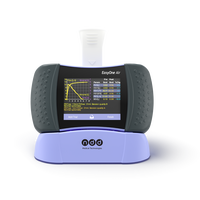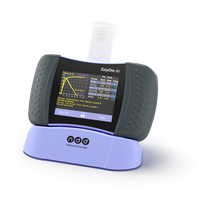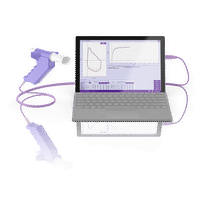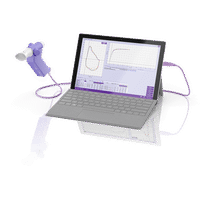The role of spirometry in asthma: Guidelines providers should know

Every year, to highlight the impact of asthma and allergies, especially during spring, the Asthma and Allergy Foundation of America declares May National Asthma and Allergy Awareness Month. To share in their call to action to spread awareness, we’re going to discuss the importance of a common pulmonary function test, spirometry, in the diagnosis and management of asthma.
Asthma is an extremely common pulmonary condition that affects 28 million Americans, 5 million of whom are adolescents. Characterized by airway inflammation, asthma can lead to chronic wheeze, shortness of breath, and cough.
The condition can look different for everybody — and can even look different for the same person on different days. In fact, this variable airflow limitation is one of the hallmarks of asthma and why it’s so important to confirm a diagnosis to get on the right treatment path.
The symptoms a patient is experiencing tell clinicians a lot and can certainly suggest a person has asthma, but it’s more reliable to have an objective tool to validate the clinician’s supposition.1 This is where spirometry comes in: Spirometry is a pulmonary function test that enables clinicians to assess the degree of obstruction of the airways — and also the degree of “bronchodilator responsiveness” of the airways, something that is especially important in asthma.1
Why spirometry matters in asthma #
Spirometry for diagnosis of asthma #
Once a clinician has determined that a patient’s symptoms are characteristic of asthma, the patient may be asked to perform spirometry.2 A spirometry test produces many measurements that provide information on how a person’s lungs are functioning. When it comes to the role of spirometry in asthma, two measurements are most relevant:
- Forced expiratory volume in the first second (FEV1)
- The ratio of FEV1 to forced vital capacity (FEV1/FVC)
The ratio of FEV1 to FVC helps determine whether there is an obstructive pattern in the lungs. A low ratio indicates difficulty in exhaling air quickly, which is characteristic of airway obstruction.. FEV1 is then used to assess how variable the airflow limitation is.2 As asthma symptoms can vary in magnitude and intensity, so does the degree of airflow limitation a patient may experience.
One way to assess this is for a patient to inhale a bronchodilator, a medication that opens the airways, and then perform spirometry again. If the patient’s FEV1 improves significantly (by at least 12%), variable airflow limitation is confirmed, which may be enough to officially diagnose someone with asthma.2 This is known as “bronchodilator responsiveness.”
(Important note: Asthma is a heterogeneous condition, and patients may require different treatments, which means diagnosis may take a different pathway for some.)
EasyOne spirometry machines - tailored solutions for every practice.
Explore our spirometry machines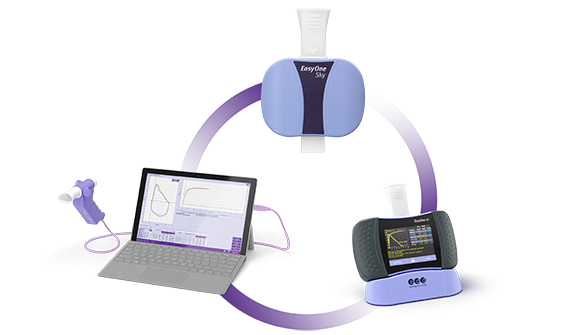
Spirometry for differentiating from other pulmonary conditions #
It is important to confirm a diagnosis of asthma first off because it ensures a patient gets on the correct treatment plan as soon as possible. Confirming a diagnosis is easier when spirometry is done at initial assessment.
In addition, it’s important to perform spirometry to ensure that there are no other co-existing pulmonary conditions. Other common pulmonary conditions can resemble asthma, such as chronic obstructive pulmonary disease (COPD). In some cases, medications indicated for COPD may even be contraindicated — or pose a risk — for those with asthma.2 Without confirming an asthma diagnosis with spirometry, patients may not receive the correct diagnosis, which can delay treatment and lead to worse outcomes.3
Spirometry for monitoring long term health #
Asthma treatment and monitoring do not end once a patient has been diagnosed and has started on a treatment that seems to work for them. Some people with asthma have a harder time keeping their asthma in control. For these patients especially, spirometry plays an essential role in assessing how well the treatment plan is working.
Regardless, it’s recommended that patients perform spirometry at least every one to two years to monitor their lung health.4
When to use spirometry #
Spirometry is important throughout a person’s life with asthma. Specifically, spirometry in asthma management occurs:
- Upon initial assessment
- Within a few months of initiating treatment to assess whether it’s the right treatment or if there needs to be a change
- During periods of increased symptoms: Patients with asthma are likely to experience ebbs and flows in their condition, in part because environmental triggers can play a big role in their health. Clinicians will leverage spirometry to assess their pulmonary health during times of progressive or prolonged asthma exacerbations.
- At least every 1-2 years to monitor and assess changes in lung function over time.4
Key guidelines to follow for asthma management with spirometry #
Asthma is a common condition that can present in different ways, making personalized care important. Fortunately, many trusted sources offer clear guidance to help clinicians effectively manage asthma and support patients in their treatment plans. These include:
- The Global Initiative for Asthma (GINA), a collaboration between the National Heart, Lung, and Blood Institute (NHLBI) and the World Health Organization (WHO) established in 1993, produces annual reports that serve as the basis for how asthma should be diagnosed, treated, and managed.2
- The American Thoracic Society/European Respiratory Society (ATS/ERS) Spirometry Standards: Proper technique, acceptability, and repeatability.5
- The NHLBI (National Heart, Lung, and Blood Institute) Asthma Care Quick Reference for Diagnosing and Managing Asthma Indications and interpretation.
- Pediatric considerations for spirometry in children.6
Conclusion: Integrating spirometry into asthma practice #
Spirometry is an essential part of diagnosing and managing asthma care by offering an objective way for measuring variable airflow limitation and responsiveness to treatments. This pulmonary function test also enables clinicians to make better decisions and informs patients of the status of their lung health, leading to better long-term control and outcomes. There are plenty of resources to make understanding the role of spirometry easier and by following these guidelines, patients are more likely to have a higher quality of life.
Ready to add spirometry to your asthma practice? Discover how the ndd EasyOne spirometers can elevate your practice today.
Upgrade your asthma practice with confidence—choose ndd EasyOne spirometers today.
Get a quote
Latifi M, Khatri S. Is spirometry necessary to diagnose and control asthma? Cleve Clin J Med. 2017;84(8):597-599. doi:10.3949/ccjm.84a.16078 ↩︎ ↩︎
Global Initiative for Asthma. Global Strategy for Asthma Management and Prevention (2024 Report). https://ginasthma.org/reports/ ↩︎ ↩︎ ↩︎ ↩︎ ↩︎
Wi CI, Ryu E, King KS, et al. Association of delayed asthma diagnosis with asthma exacerbations in children. J Allergy Clin Immunol Glob. 2025;4(2):100409. doi:10.1016/j.jacig.2025.100409 ↩︎
Gallucci M, Carbonara P, Pacilli AMG, di Palmo E, Ricci G, Nava S. Use of Symptoms Scores, Spirometry, and Other Pulmonary Function Testing for Asthma Monitoring. Front Pediatr. 2019;7:54. doi:10.3389/fped.2019.00054 ↩︎ ↩︎
Graham BL, Steenbruggen I, Miller MR, et al. Standardization of Spirometry 2019 Update. An Official American Thoracic Society and European Respiratory Society Technical Statement. Am J Respir Crit Care Med. 2019;200(8):e70-e88. doi:10.1164/rccm.201908-1590ST ↩︎
Jat KR. Spirometry in children. Prim Care Respir J J Gen Pract Airw Group. 2013;22(2):221-229. doi:10.4104/pcrj.2013.00042 ↩︎
Written by

Tré LaRosa
Tré LaRosa is a consultant, scientist, and writer in the Washington, DC area with extensive experience working in research (basic, translational, and clinical) and on patient-reported outcomes. He has also written extensively on neuroscience, pulmonology, and respiratory conditions, including from the patient perspective. He enjoys learning, reading, writing, spending time outdoors, and telling everybody about his mini golden retriever, Duncan.

